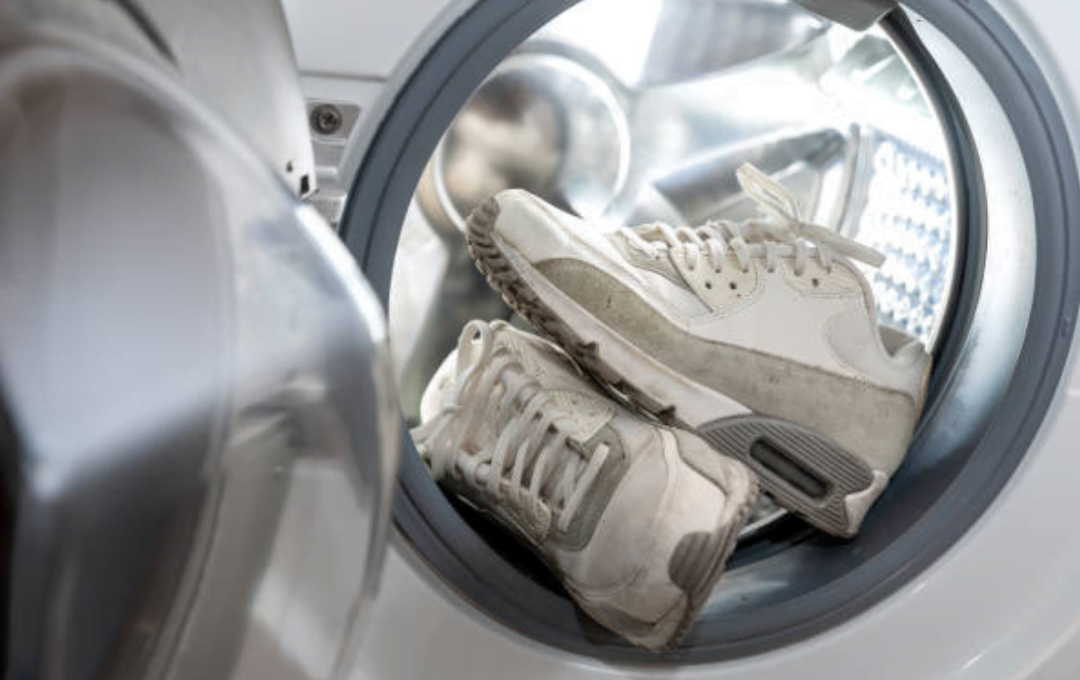A Convenient Solution for Cleaning Shoes in the Washing Machine

Cleaning Shoes in the Washing Machine – Maintaining the cleanliness of our shoes is an essential part of our daily routine, but it can often be a tedious and time-consuming task. Fortunately, the modern washing machine has provided us with a convenient solution – the ability to clean our shoes in the washing machine.
This method of cleaning shoes in the washing machine has become increasingly popular, as it offers a quick and efficient way to keep our footwear looking fresh and new.
Read: How to Wash Shoes in Washing Machine
The Benefits of Cleaning Shoes in the Washing Machine
One of the primary advantages of cleaning shoes in the washing machine is the time and effort it saves. Instead of manually scrubbing and scraping our shoes, we can simply toss them into the machine and let the water, detergent, and agitation do the work for us. This not only saves us valuable time but also reduces the physical strain associated with traditional shoe cleaning methods.
Another benefit of cleaning shoes in the washing machine is the improved cleanliness of our footwear. The powerful cleaning action of the washing machine can effectively remove dirt, grime, and even stubborn stains that may be difficult to remove by hand. This ensures that our shoes not only look clean but also feel fresh and odor-free.
Preparing Shoes for the Washing Machine
Before cleaning shoes in the washing machine, it’s important to properly prepare them. This involves removing any loose debris, such as dirt or pebbles, from the soles and uppers of the shoes. It’s also a good idea to check the manufacturer’s instructions to ensure that the shoes are suitable for machine washing.
Some shoes may have delicate materials or components that could be damaged by the washing machine. In these cases, it’s best to hand-wash the shoes or use a more gentle cleaning method.
The Washing Process
When cleaning shoes in the washing machine, it’s important to follow a few simple steps to ensure the best results:
1. Sort and Load
Sort the shoes by material and color, and load them into the washing machine. It’s best to wash similar items together to avoid any potential color transfer or damage.
2. Use the Right Detergent
Choose a mild, non-bleach detergent that is suitable for the materials of your shoes. Avoid using harsh chemicals or fabric softeners, as these can damage the shoes.
3. Select the Appropriate Cycle
Set the washing machine to a gentle or delicate cycle, and use a low-spin setting to prevent the shoes from becoming misshapen or damaged.
4. Air Dry
Once the washing cycle is complete, it’s best to air-dry the shoes rather than putting them in the dryer. This helps to preserve the shape and integrity of the shoes.
Tips for Successful Shoe Cleaning in the Washing Machine
To ensure the best results when cleaning shoes in the washing machine, here are a few additional tips:
1. Use mesh bags or pillowcases to protect the shoes during the washing cycle.
2. Stuff the shoes with paper or cloth to help them maintain their shape during the wash.
3. Check the shoes periodically during the wash cycle to ensure they are not becoming tangled or damaged.
4. Consider using a small amount of white vinegar or baking soda to help deodorize and freshen the shoes.
What are the Risks of Cleaning Shoes in a Washing Machine
There are several risks associated with cleaning shoes in the washing machine:
1. Damage to the shoes: The agitation and tumbling action of the washing machine can potentially damage delicate materials like leather, suede, or satin. This can lead to scuffs, discoloration, or even tearing of the shoe fabric.
2. Shrinkage: The heat and agitation of the washing machine can cause some shoe materials to shrink, especially if they are made of low-quality materials. This can affect the fit and comfort of the shoes.
3. Damage to the washing machine: Shoes with metal eyelets, buckles, or other hard components can potentially damage the drum or other parts of the washing machine if they are not properly secured in a mesh bag or pillowcase.
4. Discoloration: The washing process can cause some shoes to lose their color or bleed onto other items in the wash. This is especially true for shoes made with low-quality dyes or materials.
5. Odor retention: If shoes are not thoroughly dried after washing, they may retain unpleasant odors or develop mold and mildew.
To mitigate these risks, it is important to carefully follow the manufacturer’s instructions for washing shoes, use a gentle cycle with cold water, and air-dry the shoes completely before wearing them again.
What Types of Shoes are Safe to Wash in a Washing Machine
Based on the search results, the following types of shoes are generally safe to wash in a washing machine:
1. Shoes made of cotton, polyester, canvas, nylon, or other synthetic fabrics.
2. Sneakers, flats, and cloth penny loafers are examples of shoes that are suitable for machine washing.
3. Some PU (polyurethane) or PVC (polyvinyl chloride) shoes may also be machine washable, but it’s important to check the care label first.
The search results caution against washing the following types of shoes in a washing machine:
1. Leather, suede, or rubber shoes – These materials can be damaged by the agitation and water in the washing machine.
2. Shoes with delicate materials like satin or silk, or those with embellishments like beading or sequins.
3. Shoes that are not explicitly labeled as machine washable by the manufacturer.
What are Some Common Mistakes to Avoid when Washing Shoes in a Washing Machine
Some common mistakes to avoid when washing shoes in a washing machine include:
1. Not Checking the Shoe Material: Avoid washing shoes made of delicate materials like leather, suede, or silk in the washing machine, as these materials can be damaged by the agitation and water.
2. Skipping Pre-Cleaning: Always pre-clean your shoes by removing dirt and debris before putting them in the washing machine to prevent damage and ensure a thorough wash.
3. Using the Wrong Cycle and Temperature: Select a gentle or delicate cycle with cold water to prevent shrinking, color fading, or damage to the shoe material.
4. Not Removing Laces and Insoles: Take out laces and insoles before washing to prevent tangling and ensure a more effective cleaning process.
5. Overloading the Machine: Avoid washing too many shoes at once, as this can lead to uneven cleaning and potential damage to both the shoes and the washing machine.
6. Using Harsh Detergents: Opt for a mild, non-bleach detergent suitable for shoe materials to prevent damage and color fading.
7. Skipping Air Drying: Never put shoes in the dryer after washing, as the heat can damage the shoes and cause warping. Instead, air dry them thoroughly before wearing them again.
Conclusion
Cleaning shoes in the washing machine is a convenient and effective way to keep our footwear looking and feeling its best. By following the proper preparation and washing steps, we can enjoy the benefits of clean, fresh-smelling shoes without the hassle of traditional cleaning methods. Whether you’re dealing with everyday dirt and grime or stubborn stains, the washing machine can be a valuable ally in maintaining the cleanliness and longevity of your shoes.






